Micron's ClearNAND: 25nm + ECC, Combats Increasing Error Rates
by Anand Lal Shimpi on December 2, 2010 12:01 AM ESTEleven months ago Intel and Micron, jointly as IMFT, announced intentions to move to 25nm NAND by the end of 2010. For the past few months, IMFT has been shipping 25nm NAND although none of it has ended up in the high performance SSDs we love to cover just yet.
The problem, as with a jump to any new manufacturing node, has to do with yields. In the microprocessor space, new processes generally mean you can’t reach your clock targets and you may use more power than you’d like. The more experience you have in working with the process the more you can get these two variables under control and eventually you have a technology you can ship to the market.
The same is true with NAND, although the vectors of improvement are a bit different. Rather than clock speed and power (although both are affected) the main focus these past few months has been increasing endurance and reducing uncorrectable bit error rate.
When I first started reviewing SSDs IMFT was shipping 50nm MLC NAND rated at 10,000 program/erase cycles per cell. As I mentioned in a recent SSD article, the move to 3xnm cut that endurance rating in half. Current NAND shipping in SSDs can only last half as long, or approximately 5,000 program/erase cycles per cell. Things aren’t looking any better for 25nm. Although the first 25nm MLC test parts could only manage 1,000 P/E cycles, today 25nm MLC NAND is good for around 3,000 program/erase cycles per cell.
The reduction in P/E cycles is directly related to the physics of shrinking these NAND cells; the smaller they get, the faster they deteriorate with each write. Remember this diagram?

That’s an N-channel MOSFET, the building block of a NAND memory cell. Electrons travel through the tunnel oxide and make their way to the floating gate when a NAND cell is written to. The electrons are removed when a cell is erased. Each round trip is a single program/erase cycle. The process actually weakens the tunnel oxide. The smaller the tunnel oxide, the weaker it becomes, hence the decreasing p/e cycles I mentioned above.
Thankfully this doesn’t have to mean that a 3xnm SSD will die quicker than a 50nm SSD. Moore’s Law guarantees that our SSD controllers can grow in complexity and performance alongside each NAND generation. In theory, a better controller could drive write amplification lower and thus use those program/erase cycles more efficiently. This is exactly what we have seen thus far. SandForce’s SF-1200 is the perfect example of a controller-based solution to the problem of decreasing endurance with smaller geometry NAND. Even new controllers from Indilinx, Toshiba and Samsung have managed to reduce write amplification and increase performance to combat decreasing endurance.

How SandForce deals with the problem of reduced endurance and increased error rates
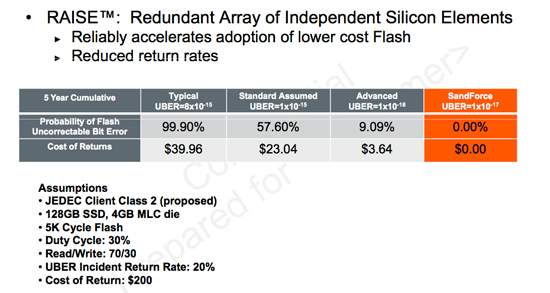
Error rates also skyrocket as a function of process geometry. The supply-demand-like curve above shows just that. SandForce integrates ECC/CRC into its controller as well as enables data redundancy across all NAND in its drives in order to combat increasing error rates with smaller geometry flash. The end result is a very forward looking, sophisticated and expensive SSD controller. What Micron plans to offer however is an alternative. It’s called ClearNAND:
The idea is simple. Instead of placing the burden of dealing with increasing error rates on the controller, Micron will internalize the problem and equip each NAND device with an ECC controller.
The NAND will still appear to be an ONFI complaint device with the same number of pins as a regular 25nm ONFI NAND device (a single unused pin, VDDI, is now put to use in ClearNAND). The bus interface remains the same and NAND controller manufacturers don’t have to do anything differently.
On each ClearNAND device you get a 24-bit BCH ECC engine, although Micron says that in another generation or two we’ll start seeing more exotic ECC algorithms.
ClearNAND will be available starting at the 25nm node in two versions: standard and enhanced. Standard ClearNAND devices are low performance, you only get up to 50MB/s per device and up to 4 simultaneous read/write ops to the device at the same time. Enhanced ClearNAND doubles maximum capacity from 32GB to 64GB per device, quadruples interface bandwidth (200MB/s) and supports up to 16 simultaneous read/write ops. Enhanced ClearNAND would be the NAND of choice for an SSD, while Standard ClearNAND would be better suited for an iPod or smartphone for example.
Raw 25nm NAND will still be available, Micron is simply offering ClearNAND as a solution to those customers who don’t want to integrate ECC engines into their controllers.
Today the need for something like ClearNAND isn’t huge, however in the next few years Micron expects ECC equipped NAND to be the most prevalent form of NAND in the market. This would make sense as error rate goes up as process size decreases, however it does assume that the ECC requirements can’t or aren’t handled at the controller level in the future.
There’s obviously a price premium associated with ClearNAND. However since we aren’t a customer of Micron, we aren’t exactly privy to specific pricing information.
Eventually we will hit a physical wall with NAND scaling. Micron reaffirmed its commitment to research into technologies that would extend the lifespan of NAND (e.g. 3D die) or potentially augment its role in a system (e.g. phase-change memory). That’s still a few generations out though.
I don’t expect to see the first consumer SSDs to use 25nm NAND (ClearNAND or raw) until 2011. Intel’s 3rd generation X25-M will be one of the first (if not the first) and is currently scheduled to ship in Q1 2011.


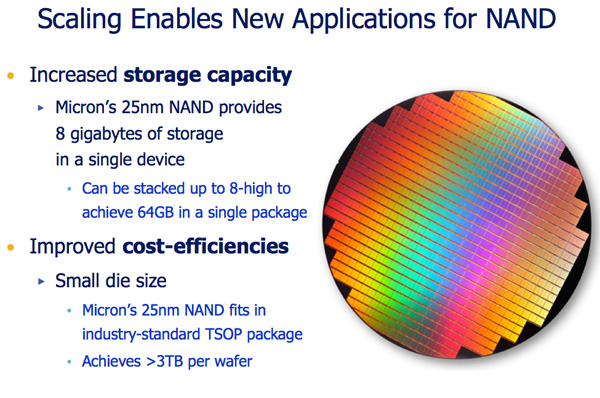



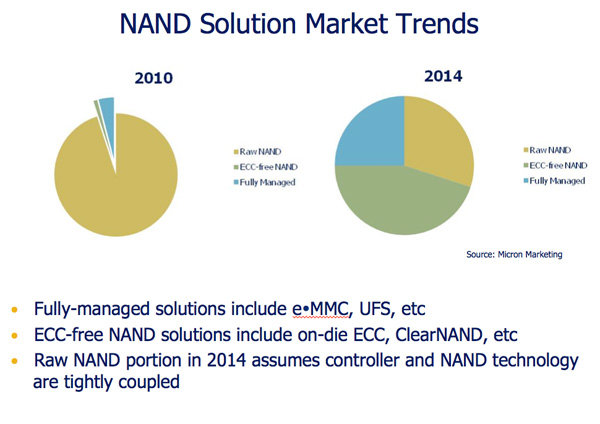
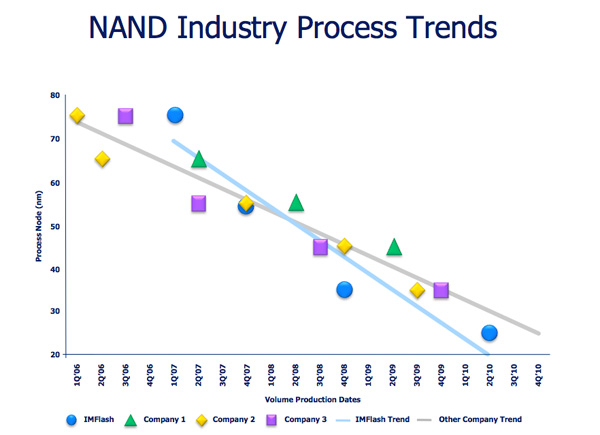
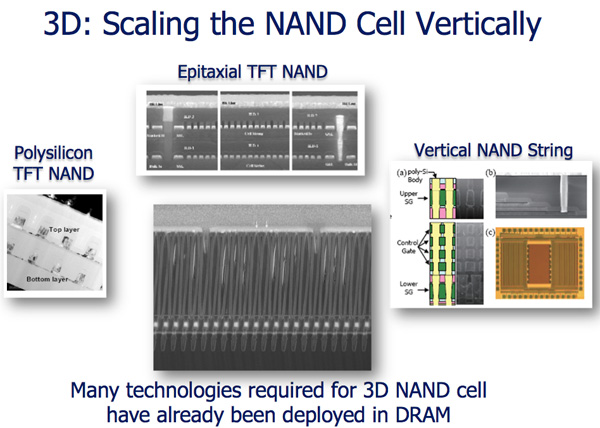
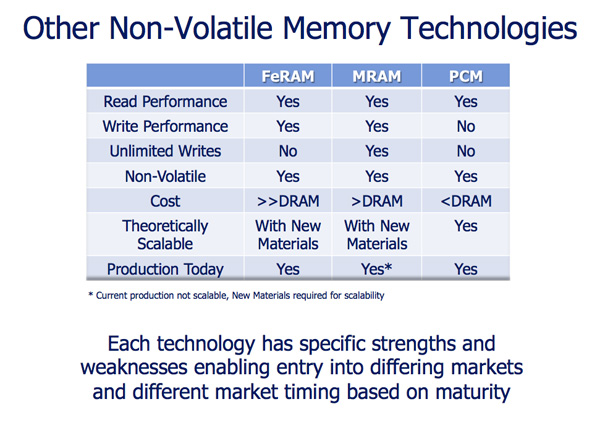








24 Comments
View All Comments
blyndy - Thursday, December 2, 2010 - link
I Read the summary. At the end of it was an ellipsis, so 'read more' show follow on from it, right? But then the article page doesn't continue from it, they don't even share the same first paragraph!?JarredWalton - Thursday, December 2, 2010 - link
We made a choice a month or so back to condense "news" stories into a smaller format on the main page, at least in the combined view. If you look above the stories you'll see buttons for "Just Reviews" and "Just News". Click "Just News" and you'll see the full summary. I like the current design, mostly because as we get more news stories they won't overwhelm the major articles. Cheers!ggathagan - Thursday, December 2, 2010 - link
Maybe the button should say "Full Article", instead.I like the synopsis approach for the front page, but the differing content *does* lend to a feeling on non-continuity, since one generally expects the type of setup the OP alludes to.
ckryan - Thursday, December 2, 2010 - link
Anand, you do a good job reporting on the SSD market. Solid state storage makes a pretty good subject for more in-depth reporting. I'm eagerly awaiting the next crop of drives to get to your bench.Right on.
redechelon - Thursday, December 2, 2010 - link
Yes, this is what I've been waiting for... not necessarily a rough release date or anything but just a detailed update about the 25nm Intel drives.When SSD's were just starting to get publicity, I was a skeptic. However, I was aiming to build a monster of a PC around that time and decided to get an Intel X-25M (which I thought would be much more of a niche product). It was definitely one of the best purchases I made however, mostly because I NOTICED the speed and responsiveness in everything from everyday tasks like opening windows to gaming load times.
Anyways, just wanted to say "Thank You!" for your in depth diagrams and amazing reviews. (even though this is just a brief one) When I read your articles, I feel not only that you know a lot about what you're talking about, but also that you ENJOY this and get as excited as any PC enthusiast would.
arnavvdesai - Thursday, December 2, 2010 - link
Isnt HP working in partnership with Micron making Memresistor based storage. How close is that to actual production samples? If Memresistors are cost feasible then wouldnt NAND based storage become a no go.I wonder if Anandtech has heard anything about this technology.
DanNeely - Thursday, December 2, 2010 - link
Apparently not until 2013http://www.technologyreview.com/computing/25018/?a...
Chloiber - Thursday, December 2, 2010 - link
Thanks for this article, interesting stuff!Keep working on such smaller "Tech"-articles regarding SSDs, they are really interesting and allow us a view under the hoods of SSDs.
Guspaz - Thursday, December 2, 2010 - link
I didn't realize that NAND P/E cycles were dropping so precipitously. No amount of error correction is going to help you when you start running out of P/E cycles. Suddenly, I don't feel so bad about only having a first-gen Intel SSD; apparently, the new third gen drives will have less than a third the lifespan at similar capacity sizes.Doesn't reducing this to 3000 P/E cycles significantly reduce the usefulness of these drives? If memory serves, Anand mentioned in the original Intel SSD launch article that Intel intended for the drives to survive 100GB of writing a day for 10 years. On an 80GB drive, that would require at least 4562 P/E cycles, which was perfectly doable when the drive had 10000 P/E cycles... It seems like Intel has abandoned this goal on anything smaller than a 160GB drive.
Mr Perfect - Thursday, December 2, 2010 - link
It would also depend on the write amplification of the controller. If Intel can get the amplification of the gen 3 controllers down, similar to what SandForce is doing, then it might be possible for low amplification gen 3 drives to last just as long as gen 1 drives.It does make you wonder though.I'd be interested to see what starts failing first, SF drives or Intel ones. Have there been any long term studies on this sort of thing?